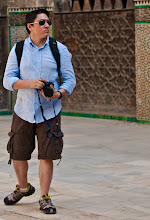Motocross Racing
One of the big advantage o this sport, is that you dont need special access to get close to the action, therefore a regular kit zoom can do most of the time to capture great images
Every race usually comprises of a few practice sessions in the morning, followed by a race in the afternoon
Focusing
Getting sharp shots of fast moving motorcycles can be very difficult. AF mode is okay if you can keep the focus point positioned on the bike before you taker the shot, or if they are going slowly. In more difficult situations such as shooting the bikes head-on over jumps; its better to use manual focus to get sharp results at the top of the hill. This takes practice to get the hang of, but allows you to get shots that auto focus might find impossible
Viewpoints
Choosing the right viewpoint will make a massive difference to any sports and action shots. Rather than simply stand where you can see the action ,look for vantage points where the background doesnt detract from the main subject. For uncluttered backgrounds, try finding a spot where you can use the sky or track as a backdrop, to concentrate all the attention on the subject
Protect your kit
Even in good weather motocross bikes are going to send plenty of dirt mud and slut your way, so you need to protect your kit. A towel or dry cloth is handy for throwing over the camera while you are not using it, and also for wiping off any gobbets of first that end up on the body of the camera. In very bad conditions it might make sense to use an entire rain cover for the camera
One good thing to do is to get familiar with curse, look at where the sun will beat the time of the race so that you dont get too many shots with the highlight of the sun on the bikers, also look after practice for the little canals that the riders leave behind, since they will tend to reuse those over and over when they hit a curve, you can choose a spot close to that as this will be an indication of where the riders will be going trough
One good location is to choose a jump area, sit there and wait for the bikes to come into view, use Shutter Priority Mode or Manual, focus manually on the top of the rise and set your shutter speed to 1/1000 second. this should freeze the action on the jump
Another good location as well is standing slightly above the track around the bends on the corners of the circuit. You can get away with using a smaller lens, 18-70mm as the riders will be much closer as well as they will be slowing down to take the curve, this viewpoint will provide you with a much better backdrop of the dirt. Here with the new speed of the bikes you can go down to 1/125 secs you could also use flash to help you freeze some of the movement.Also try your panning technique.



